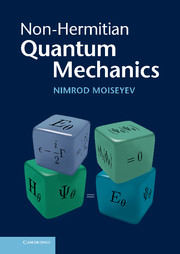Book contents
- Frontmatter
- Contents
- Preface
- 1 Different formulations of quantum mechanics
- 2 Resonance phenomena in nature
- 3 Resonances from Hermitian quantum-mechanical calculations
- 4 Resonances from non-Hermitian quantum mechanical calculations
- 5 Square integrable resonance wavefunctions
- 6 Bi-orthogonal product (c-product)
- 7 The properties of the non-Hermitian Hamiltonian
- 8 Non-Hermitian scattering theory
- 9 The self-orthogonality phenomenon
- 10 The point where QM branches into two formalisms
- Index
10 - The point where QM branches into two formalisms
Published online by Cambridge University Press: 03 May 2011
- Frontmatter
- Contents
- Preface
- 1 Different formulations of quantum mechanics
- 2 Resonance phenomena in nature
- 3 Resonances from Hermitian quantum-mechanical calculations
- 4 Resonances from non-Hermitian quantum mechanical calculations
- 5 Square integrable resonance wavefunctions
- 6 Bi-orthogonal product (c-product)
- 7 The properties of the non-Hermitian Hamiltonian
- 8 Non-Hermitian scattering theory
- 9 The self-orthogonality phenomenon
- 10 The point where QM branches into two formalisms
- Index
Summary
Although the standard formalism of quantum mechanics is based on the requirement of the physical operators to be Hermitian, the use of non-Hermitian operators in the study of different types of phenomena is not uncommon. One of the most well-known non-Hermitian potentials is the optical potential where for any given choice of N channels the exact eigenvalue is a solution of a single-channel problem. The optical potential is a non-Hermitian, non-local and energy-dependent operator. In his book on scattering theory Taylor writes: “In practice, the optical potential is far too complicated for exact use in actual calculations”. It is often believed that the complex energies which are obtained by the use of optical potentials result from the approximations in the calculations. However, this is not true. The complex energy obtained by solving the one-channel problem with an optical potential is the exact eigenvalue of the original N-channel problem which is obtained by imposing outgoing boundary conditions on the eigenfunctions of the time-independent Schrödinger equation. In this chapter we wish to show that the study of the resonances in multi-channel problems (so-called Feshbach resonances) can be considered as the point where quantum mechanics branches into the standard (Hermitian) and non-standard (non-Hermitan) formalisms.
Feshbach resonances
Quite a long time ago Feshbach showed that the exact energy spectrum of the full physical problem can be obtained by solving two different self-energy problems.
- Type
- Chapter
- Information
- Non-Hermitian Quantum Mechanics , pp. 375 - 392Publisher: Cambridge University PressPrint publication year: 2011



